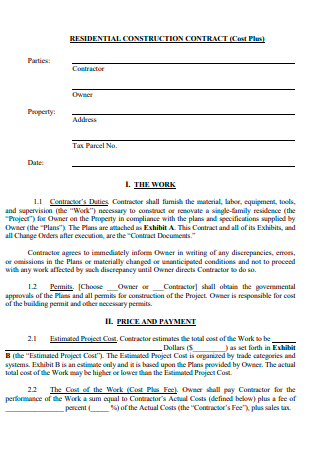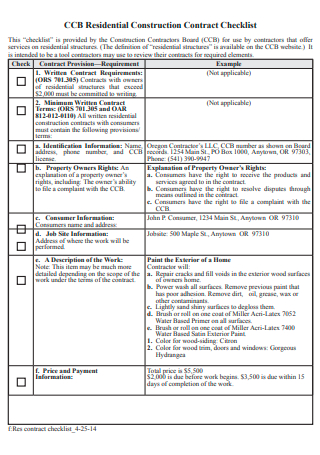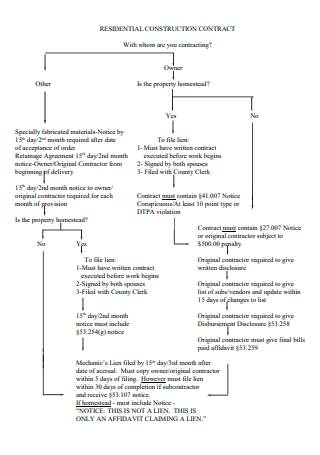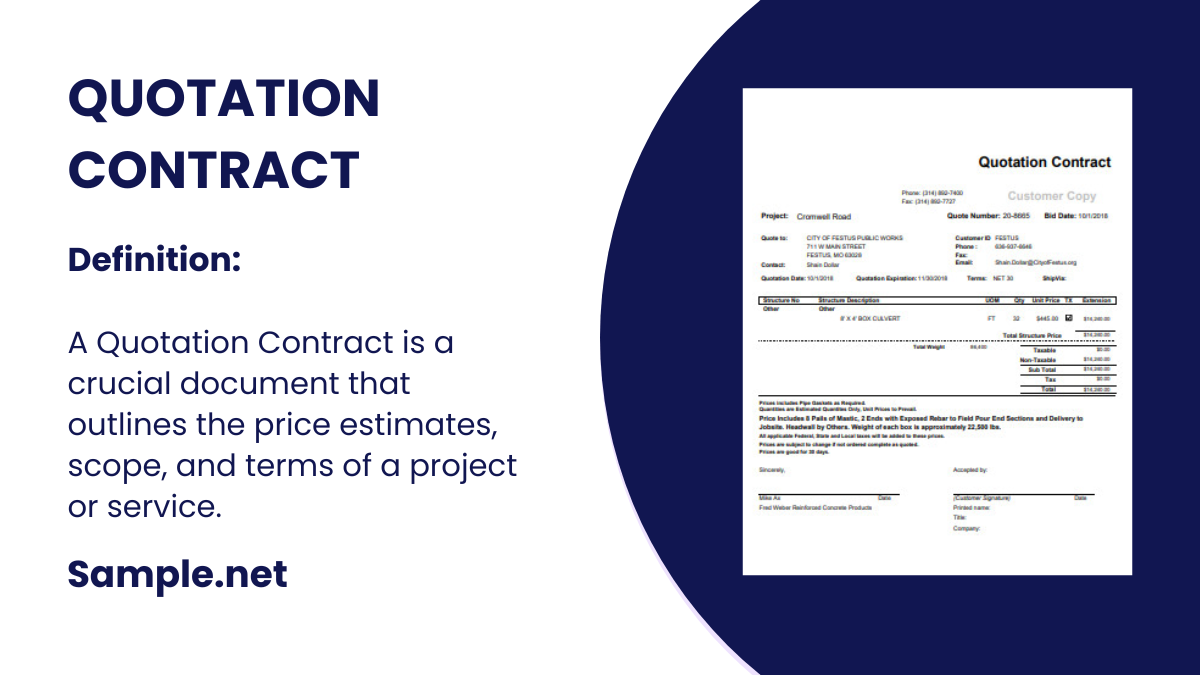3+ Sample Residential Construction Contract
What Is a Residential Construction Contract?
A residential construction contract is a formal agreement between the contractor and the property owner or homeowner. A contract with a contractor can be signed by anyone or any entity who want to construct a residential building. It includes contractor agreements outlining the rights of the contractor to halt the project or withhold payment. The contract would also specify how much the construction would cost and whether it would be paid in installments or in whole. The contract would also include a description of the task as well as the expected completion date and construction schedule. It should specify remedies in the event of contract breach or termination.
Different Types of Residential Buildings
One of the most popular types of architecture is residential buildings. Vacant lots can be developed into apartment complexes and condominiums. It not only helps to increase the value of the neighborhood, but it also contributes to provide housing. Which is its goal. And in today’s modern world, it’s simply a matter of making the correct investment and locating the right site to begin any construction work.
Single Family Homes: At least one family lives in a single-family home. The dwelling is a typical family unit that can be found in either rural or suburban regions. Alternatively, subdivisions with a similar set up. Single-parent households are ideal for providing children with a secure upbringing. It not only has essential necessities and rooms, but it also has additional space for the family to use. Some family houses include yards in the front and back that are ideal for children to play in without having to risk travelling to parks. A single-family home construction agreement is normally between the family and the contractor. This is because, unlike condominiums and apartments, these residential buildings are primarily used for personal purposes. Of course, a single-family home subdivision can be considered commercial housing. Or if it is part of a property buying and selling. Condominium: Condominiums are extremely valuable. It can accommodate many apartments due to the large property complex. A condominium often has multiple stories. Condominium units, on the other hand, are owned, as opposed to apartments. Or, at the very least, there is a plan to own until the tenant has fully paid for the unit. The buyer will thereafter be the owner of the unit. Condo owners, have a joint ownership stake in community properties. These are often outdoor areas such as stairwells, sidewalks, and floor halls. Condo owners must continue to pay maintenance fees and any form of upkeep. They own the space, or more specifically, the air space, within the unit. However, this does not apply to the four walls they share with other owners. Condominium construction contracts are tremendously rewarding. It not only makes better use of a plot of land by expanding vertically, but it also makes more money. Because owning a condo may be done in installments, it is often well-received by upper middle-class people. Apartments: Apartments and condominiums are extremely similar. The primary distinction between the two is that flats are rented, whilst condos are owned. Apartment dwellers generally share common areas with other renters. Apartments are less expensive than condominiums. This is since it is only for rent. And the landlord oversees maintenance as well as ensuring that the communal spaces are safe and tidy. Apartments are advantageous for college students who study away from home. It’s inexpensive and provides ample space for sleeping and dining. Apartments differ in terms of size and facilities. The most popular type of apartment is a one-bedroom or studio apartment. Residential building contractors might also earn greatly from apartment construction. Although it is less expensive than a condominium, it is a popular type of residential housing in the metropolitan area. Townhouses: Townhouses are frequently uniformed dwellings. It’s multi-story and particularly common in suburban regions with townhouse subdivisions. Townhouses are narrower and significantly smaller than ordinary family homes. Its exterior two walls are also connected to those of neighboring townhomes. Where the houses are arranged in a row with identical design, layout, and size. Some townhouses have a little lawn or yard in front of them. Townhouses are technically classified as condominiums. Townhouses, rather than high-rise buildings, are lined up in suburban or even urban locations.
Benefits of Staying in Residential Buildings
Staying in a residential complex has several advantages. What about the constructing? It is still being criticized. However, residential high-rises frequently represent a city’s and its residents’ prosperity. The higher the value of your home, the closer it is to a major city. In other words, home prices climb as one gets closer to the city’s central business district. This is because demand in urban areas is much higher than in suburban and rural locations.
Safety: Security is provided by condominiums, apartments, townhouses, and subdivisions. The houses are close together, and the neighborhood is gated. Typically, only the owners or renters are permitted to enter and exit. Outside guests may not be permitted to enter based on the rental agreement. Security is also very strict. They place a high importance on the safety of their residents. Residential buildings not only have security guards, but they also have CCTV cameras and are constantly patrolled. They will also be equipped with the required firefighting equipment. They would also have fire alarms and smoke detection. Most residential buildings perform routine maintenance and fire risk assessments. This, in turn, adds to the safety of its citizens. Maintenance: In terms of maintenance, most residential buildings have associations or owners who assist in the upkeep of the property. Residents may be charged additional upkeep fees. Although it may appear to be costly, it will be critical in ensuring that the living circumstances are safe. It could discover any problems ahead of time. Maintenance is frequently handled by management. It minimizes not only the expense but also the time required to maintain a home once it has been purchased. When a person is always busy and working, it might be difficult to maintain a property. When someone does not know what exactly needs to be fixed, it may be difficult to notice problems and determine what has to be fixed. Communal Facilities: The best thing about residential buildings is that they frequently have communal spaces. Residents may be able to use facilities such as pools, gyms, sport centers, and gardens for free. However, it would be accessible to all residents of the same residential complex. Although it may appear that privacy would be a concern, sharing spaces could help promote neighborly ties. It would also encourage children to participate in recreational activities. It is simple for children to form friends when they are surrounded by people who share similar living conditions. The amenities and facilities available in each complex would have to differ. Providing these amenities will also assist to raise the value of the homes. Families would prefer that their children grow up in environments that allow for safe interaction. Recreational activities aid in the promotion of fitness and immunity. That is more useful in the long run. Parents could also watch their child participate in enjoyable activities where their safety is guaranteed. Financial Advantage: Rent-to-own properties include condominiums, townhouses, and even single-family homes. That is, you simply must pay a down payment and monthly fees in addition to interest. It would be more cost effective than purchasing your own land and investing in building construction. Before a residential building is put up for sale, it already has all its amenities and rooms. As a result, you can save more and utilize the rest of your money to buy furniture. It also aids in financial management when there is no need to spend a large sum of money to build a house. Not only that but owning a condominium or a townhouse may let you to rent it out to tourists or locals. That would imply an additional source of income that could genuinely be a lifeline in times of need. And, while saving for a permanent home, renting a house isn’t necessarily a bad thing. Community: Residential homes frequently establish their own communities. And a community looks out for one another. During interactive connections, there is a healthy dynamic that can be sought and seen. Which is important in acquiring social skills and assimilating into society. Depending on how involved this community is, there may be parties and events held by homeowner associations. Not only will it allow someone to interact with their immediate surroundings, but it will also allow them to get to know the person across the hall or street. And it’s critical to make contacts that can be handy when someone needs their assistance. And, in general, residential buildings house people of various ages. From babies and children to adults and the elderly. It’s a great location for youngsters to socialize with their peers in a safe environment. It also assists adults in getting to know the parents of their children’s friends. Enough Living Space: Residential buildings strive to provide not only a home, but also a space that may be called a home. A room for families to live together should be adequate not suffocating. Apartments and single-family homes may be able to provide this level of comfort. And there are numerous options from which to pick. There is the option of relocating further from the city, where rent is slightly lower. People who work from home may benefit from this. If the job is demanding, one could look for an apartment with ample space. A person requires a place to sleep and eat in which they are at ease. A location that is structurally and security-wise protected. It aids in the management of stress in daily tasks involving demanding jobs. Isn’t it satisfying for the contractor to have a work order to build those kinds of structures?
Steps on How to Make a Residential Construction Contract
There are various kinds of home construction contracts. Typically, it differs according on set prices and building costs. Alternatively, how each unit would be charged. However, in general, they would contain similar relevant content.
-
Step 1. Names and Contact Information
The contract should include both the contractor’s and the client’s names. This contains further information such as their phone number or email address. It’s also a good idea to write down the contractor’s license number and the company address. It should also explain where the construction will take place and the status of ownership for the homeowner. It is critical to confirm the property’s ownership.
-
Step 2. Project Cost
There should be an estimate of the overall cost of the project’s construction. Also, if the payment would be done in installments with a down payment. Or, perhaps, in its whole. This should also include payment due dates. As well as a contract termination clause if the homeowner is unable to secure financing or sufficient funds to pay.
-
Step 3. Description of the Project
As previously said, there are several types of residential buildings. It is critical to describe the building in detail in this section. Whether it’s a condo, an apartment, or a townhouse. A blueprint could also be attached in the contract afterwards. Describe what is being built and when it is expected to be completed. If there is a deadline for completion, it is critical that it be indicated in the contract. That is to indicate that the client and contractor have reached a complete agreement.
-
Step 4. Rights and Termination
It is also vital to establish the rights of both parties in the contract. For example, if the homeowner fails to pay, the contractor has the authority to halt the project. Of course, workers should be well compensated. It would be unjust to them. At the same time, the homeowner may withhold payment if the constructor fails to meet specific standards. They, for example, did a poor job of creating some portions. And the homeowner thought it was a poor job. It should be specified in the contract so that both parties can agree.
-
Step 5. Signature and Date
There is a small section at the conclusion of the contract where signatures can be added. It is critical that both signatures are there, as well as the date the signature was signed.
FAQS
What Is the Importance of a Residential Construction Contract?
A home construction contract is crucial because it establishes the necessary clauses that both parties must be aware of and agree to. The contract would not only outline the project, but it would also specify how payment and compensation would be made. More crucially, both parties’ rights to terminate or withhold payments. A contract is essential, particularly for large development projects. It not only provides security for both parties, but it also specifies their responsibilities.
What Does a Residential Construction Contract Include?
The names of both the contractor and the client are listed in the contract. As well as the constructor’s company location and license number. They should mention the client’s address and the location of the construction. Another section of the contract describes the project and its completion deadlines. It should also specify the rights to termination, withholding of remuneration, or a work stop order. Liabilities and compensation should also be specified in the contract.
What Are Some of the Risks of Large Residential Construction?
There are various dangers associated with residential building. There is a risk of bodily harm not just to workers but also to passers-by or nearby occupants. Because of the chemicals and materials used in construction, the soil may also be contaminated. Carbon monoxide poisoning is a significant issue, as is mold growth in unmaintained residential buildings. Fluid discharge from used equipment may also be an issue for the environment and individuals. That is why it is critical to take steps to limit the damage to its surroundings.
A residential contractor is well-versed in construction contracts. And its significance is reinforced by the fact that it can benefit all parties involved. A construction project not only puts workers in danger, but it also costs a lot of money and time. And the solution is to use a residential construction contract pdf to make sure both parties are liable and informed. Download a residential construction contract template here at Sample.Net!






